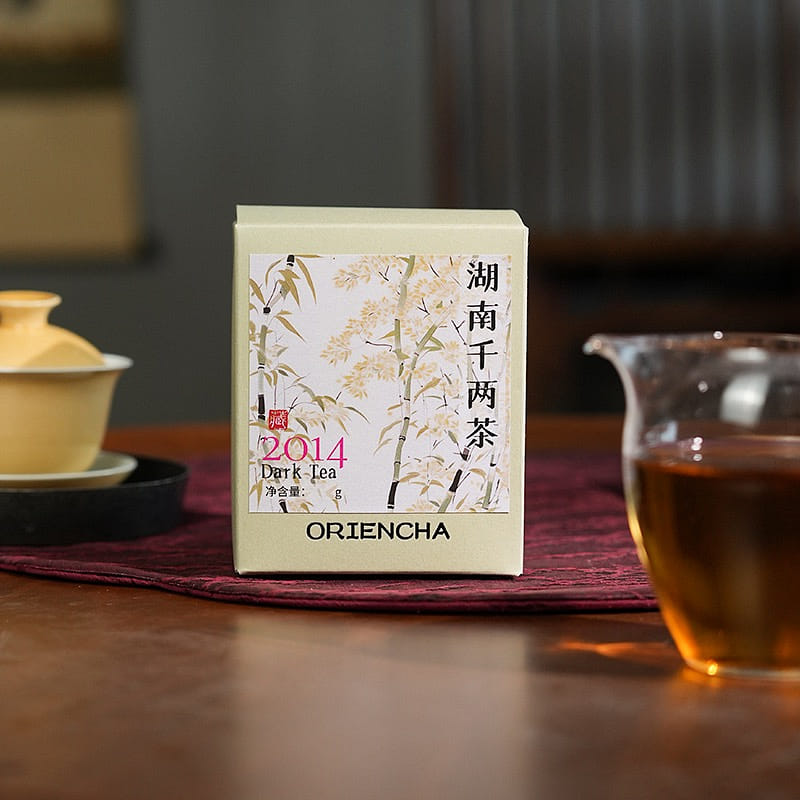Hunan Anhua Qian Liang Dark Tea (hei cha) 100 g
Chi Tiết
Mô tả
Product Description
Qian Liang Tea (千两茶 Thousand Liang Tea) has a history that dates back to the Tongzhi period (1862-1875) of the Qing Dynasty. It is an ancient tea with a unique production process. The tea is compressed using a traditional trampling technique that requires the collaborative effort of 6-8 skilled craftsmen. This process produces tea rolls with uniform and compact textures. In 1983, staff at the Palace Museum in Beijing discovered two "tree-shaped tea trunks" while sorting through Emperor Jiaqing's artifacts, providing physical evidence that these tea rolls were imperial tribute tea during the Qing Dynasty. In 1997, Baishaxi Tea Factory fully restored the production of these tea trunks, making what was once imperial tribute tea affordable for ordinary people. In 2008, the craft of making Anhua Qian Liang Tea was officially listed as a National Intangible Cultural Heritage of China. Known as the "King of Teas," Qian Liang Tea's esteemed reputation perfectly encapsulates its rich history, striking appearance, unparalleled craftsmanship, and profound inner qualities.
This particular Qian Liang Tea, produced in 2014, was crafted using carefully selected old tea trees of the Yuntai large-leaf variety 云台大叶种 from the Xuefeng Mountain range 雪峰山脉 in Anhua. The tea was handpicked, using only the "Hua Bai Geng” (花白梗 speckled white stalks) fresh leaves as raw material. Following ancient Qing Dynasty methods, the tea was manually pressed and sun-dried. It was stored in its original form in the standardized tea warehouse of Baishaxi for eight years of aging and transformation before being cut into tea cakes. During the summer, skilled craftsmen are selected to form teams and manually process the tea using traditional trampling techniques. From start to finish, each Qian Liang Tea is entirely handcrafted, with no involvement of machines or modern tools. Even the drying process is done naturally through sun exposure.
The dry tea carries a faint smoky aroma, which is both aged and pure. The storage environment is clean, free from any musty, or foreign odors. It exudes honey fragrance, bean curd aroma, and milky notes. The aroma is rich and persistent, with a sweet and lasting scent that lingers on the cup. The taste is mellow, smooth, and sweet, with a refreshing smoothness upon entry and a distinctive mountain terroir character.
Basic Information
Origin: Hunan, China
Variety: Yuntaishan Large-leaf Variety
Harvest: Spring 2014
Oxidation: Oxidized
Caffeine: Low
Theanine: High
Catechin: Medium
Steeping Guidelines
Gaiwan or Yixing Teapot
Enjoy the tea infusion by infusion to appreciate its evolving flavors. Use a tea-to-water ratio of 1:12 with boiling water at 212°F (100°C) . Rinse the first infusion for 30 seconds and discard the tea liquor. Begin drinking from the second infusion, steeping for 20 seconds. For subsequent infusions, increase the steeping time by 5 seconds. The tea can be steeped more than 12 times.
Boiling Method
This method fully extracts the active components, resulting in a rich, sweet, and flavorful tea. Use a tea-to-water ratio of 1:120. Add tea to the pot when the water reaches 80°C and bring it to a full boil. Boil for 15 minutes before drinking. When enjoying the tea, leave one-third of the tea liquor in the pot and add more water to continue boiling. This can be repeated more than three times.
Thermos
This method produces a concentrated broth while maintaining heat and aroma. Using a Thermos teapot or Thermos teacup at a tea to water ratio of 1:150 (for example, 4 grams of tea to 600 milliliter of water). Place the tea leaves in the stainless steel filter. Pour boiling water (212°F or 100°C ) into the teapot. Close the lid tightly and let the tea steep for one hour to allow the flavors to fully develop. After an hour, pour the tea into cups and enjoy the rich, mellow taste. Can immersed multiple times.


